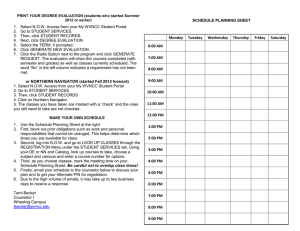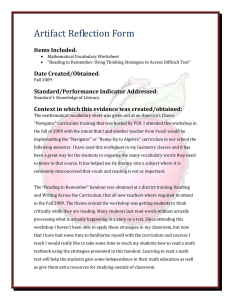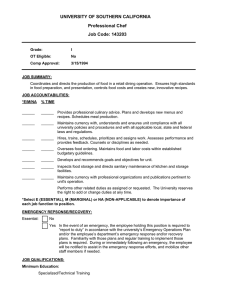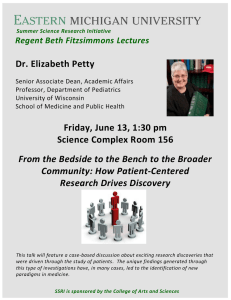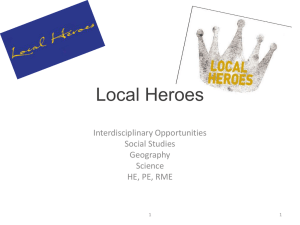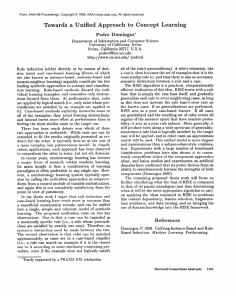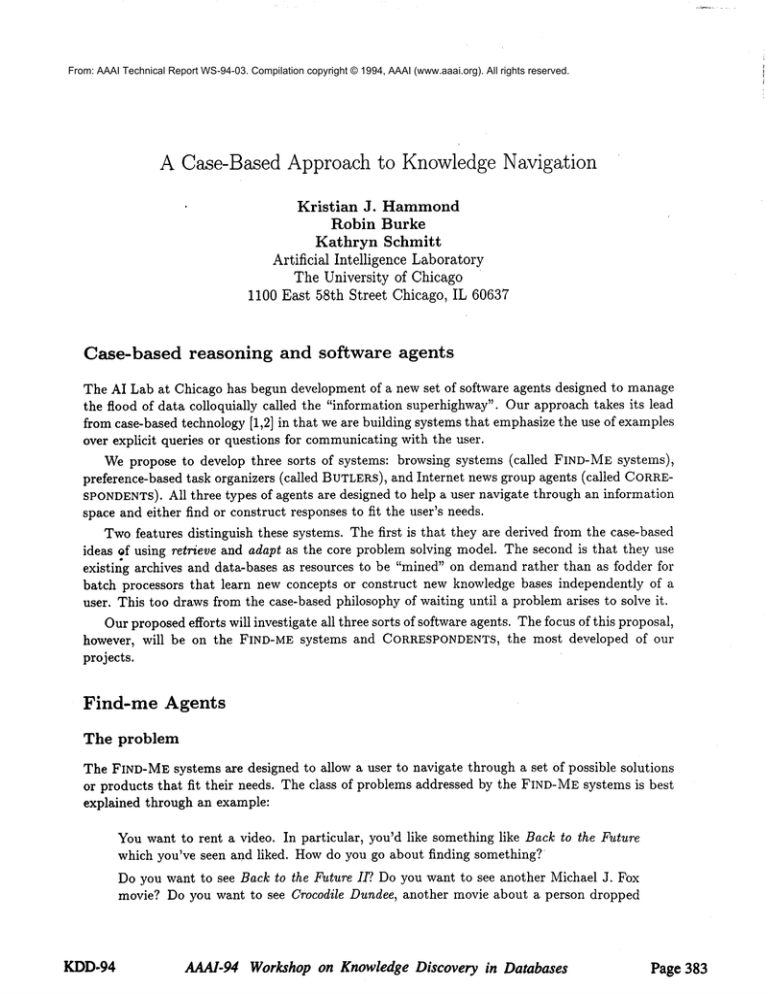
From: AAAI Technical Report WS-94-03. Compilation copyright © 1994, AAAI (www.aaai.org). All rights reserved.
A Case-Based Approach to Knowledge Navigation
Kristian
J. Hammond
Robin Burke
Kathryn Schmitt
Artificial Intelligence Laboratory
The University of Chicago
1100 East 58th Street Chicago, IL 60637
Case-based
reasoning
and software
agents
The AI Lab at Chicago has begun development of a new set of software agents designed to manage
the flood of data colloquially called the "information superhighway". Our approach takes its lead
from case-based technology [1,2] in that we are building systems that emphasize the use of examples
over explicit queries or questions for communicatingwith the user.
We propose to develop three sorts of systems: browsing systems (called FIND-MEsystems),
preference-based task organizers (called BUTLERS),and Internet news group agents (called CORRESPONDENTS).
All three types of agents are designed to help a user navigate through an information
space and either find or construct responses to fit the user’s needs.
Twofeatures distinguish these systems. The first is that they are derived from the case-based
ideas Qf using retrieve and adapt as the core problem solving model. The second is that they use
existing archives and data-bases as resources to be "mined" on demandrather than as fodder for
batch processors that learn new concepts or construct new knowledge bases independently of a
user. This too draws from the case-based philosophy of waiting until a problem arises to solve it.
Our proposed efforts will investigate all three sorts of software agents. The focus of this proposal,
however, will be on the FIND-ME systems and CORRESPONDENTS, the most developed of our
projects.
Find-me
Agents
The problem
The FIND-ME
systems are designed to allow a user to navigate through a set of possible solutions
or products that fit their needs. The class of problems addressed by the FIND-ME
systems is best
explained through an example:
Youwant to rent a video. In particular, you’d like something like Back to the Future
which you’ve seen and liked. Howdo you go about finding something?
Do you want to see Back to the Future I17 Do you want to see another Michael J. Fox
movie? Do you want to see Crocodile Dundee, another movie about a person dropped
KDD-94
AAAI-94 Workshop on Knowledge Discovery
in Databases
Page 383
into an unfamiliar setting? Time After Time, another time travel film? Who Framed
Roger Rabbit?, another movie by the same director?
The goal of the FIND-ME
project is to develop systems that deal with this sort of search problem.
These problems relate to domains with the following features:
¯ There are many choices. (Approximately 20,000 in the video domain.)
¯ Newelements cannot be generated by the system or the user. (The system cannot recommend
a movie that doesn’t yet exist.)
¯ The space is defined by a vocabulary of features that maynot be accessible to the user. (How
many people would know to describe Back to the Future as an instance of a "stranger in a
strange land" theme?)
¯ The user discovers new examples in the course of his or her search. (New movies that the
user hasn’t seen are presented.)
¯ The user discovers the features that define the domain in the course of his or her search.
(Figuring out that "buddy" films exist.)
¯ While they may not be able to articulate their own absolute constraints, users are able to
comment on examples. (You may not know exactly how funny you want a movie to be, but
you know that To Kill a Mockingbird doesn’t match your preferences.)
¯ Finally, person-to-person interaction within the domain takes the form of trading examples.
(e.g., "If you liked Back to the Future, you’re sure to like Crocodile Dundee.")
Manycomplex selection problems have these characteristics,
for example, personnel selection.
It is difficult to specify completely what kind of person is right for a job, but it is easier to look
at a person’s resume and come up with a response such as "Give me some one like this, but with
more leadership experience."
In order to cope with these task features, we take the approach in FIND-ME
of always presenting
examples and allowing the user to suggest changes, which then are used to retrieve further examples.
The user never has to articulate exactly what he or she wants, but only has to commenton what
is right (or wrong) with an example that they are looking at. Users move through the space
looking at examples and communicatingtheir likes and dislikes to the system. The system responds
by adjusting its search strategy. By working from examples we avoid the need for the user to have
extensive prior knowledgeabout the domain in order to find what he or she wants in a database.
The central
ideas
The FIND-MEprojects are driven by three main concerns: interface
through examples, and the support of non-hierarchical
search.
metaphors, reasoning
Oneof the core ideas of the FIND-ME
systems is to develop user interfaces that are metaphorically linked to knownartifacts.
Just as the Macintosh environment makes use of the desk-top
metaphor, we have constructed interfaces that are analogs to existing artifacts that aid search
Page 384
AAAI-94 Workshop on Knowledge Discovery
in Databases
KDD-94
within a domain. This allows users to have strong predictions about the effects of their own actions, reducing the explanatory burden on the systems. The overall goal is to provide users with a
sense of where they are in the domain space and how they got there.
The aim is to protect the user from the fact that he or she is searching through an multidimensional feature space. Instead we present the user with a familiar artifact, such as a magazine
or video store aisle, that has the added feature of being dynamic. This means that users can
browse through an environment that stays stable with respect to what they have already seen, but
is dynamic in that the next items are always those suggestions that the system believes the user
wants.
The second major insight that we bring to knowledgenavigation is that we can use the differences
between a presented example and a user’s target to formulate a description of the target itself which
is then used to access a knowledgebase of further examples, an iterative process of exploring the
space of examples. Rather than using the absolute features that define the space, we are far more
concerned with giving users the ability to say, in essence, "Yes, but..." and change a feature with
respect to an example.
Finally, we have designed the overall FIND-MEnotion with an eye to avoiding hierarchical
search of a space. Wedon’t see the selection process as one of narrowing. Instead we see it as
moving through a space of possibilities where any feature can be changed at any time. The danger
in a truly open-ended search in a large, multi-dimensional space is that the user can easily become
lost. To assist the user’s search, FIND-ME
systems have active clerks that constantly view a user’s
current preferences and suggest alternative tracks through the space that reflect the clerk’s unique
goal organization and retrieval strategies. For example, in our CAR NAVIGATOR,each class of cars
has its ownclerk, that attempts to change the user’s focus whena match within its class exceeds a
fitness threshold. This allows the user to break away from any tunnel vision that they might have
because of either ignoring a feature in the space or simply not knowing howthat feature has been
constraining the search.
The Car Navigator
The most mature of our systems is the CAR NAVIGATOR,
a FIND-MEsystem that allows users to
explore the domain of new cars. The interface to the CARNAVIGATOR
is designed to resemble a car
magazine. The initial page (See Figure 1) is table of contents, showing pictures of seven cars, each
labeled by class (e.g., small, compact, midsize, large). There is an icon representing each of these
classes next to the picture, and the same icons are used along the edges of the virtual magazine
as tabs into the various sections of the magazine. The user can examine cars in any car class by
clicking the tab with the icon of that class.
To start, the user selects a car class by clicking the picture of the car representing the desired
car class. The page turns and the 5 most typical examples of that car class are displayed on the
left page (See Figur.e 2). On the right page the picture of the top-most car from the left side
repeated and underneath it is a collection of icons and controls. Each icon represents an attribute
of a car, such as horsepower, price, or gas mileage.
A list of desired attributes representing the system’s current understanding of the user’s preferences is displayed to the right of the control. The user gets a feel for howwell the displayed
car matches his current preferences according to the color background of each feature. This color
pattern is echoed in the color tabs on the cars remaining on the left page. The user can adjust his
KDD-94
AAAI-94 Workshop on Knowledge Discovery
in Databases
Page 385
Figure 1: The first
page of the "Car Navigator Magazine".
preferences at will and the resulting changes in degree of match are immediately reflected in the
color fields.
Often a user requests an attribute value that cannot be attained without altering one or more
of the desired values for other attributes. This results in a "yellow light" comingon in the features
linked to the one that has been changed, followed by a Quicktime movie containing an explanation.
For example, if a user requests good gas mileage and then requests high horsepower the yellow light
will come on next to the gas mileage and horsepower features. Whenthis happens, a car salesman
explains (via a Quicktime movie) that there is a trade-off between horsepower and gas mileage.
The user will have to decrease either the desired level of fuel economyor the amountof horsepower
he is requesting.
Whenusers have set the preferences to their liking, they request the retrieval of a new set of
cars by clicking the folded corner at the bottom of the right hand page, "turning the page" to reveal
a new set of 5 cars, those that best fit the new preferences. Users’ preferences may change enough
to movethem into a different car class. If a better match is found in a car class other than the
current one, CARNAVIGATORsignals this fact with a yellow exclamation mark displayed over the
tab with the icon representing the car class with the better match. Users can turn to this section
to see the proposed alternative.
The ability to make small changes in the search criteria and see corresponding examples is
Page 386
AAAI.94 Workshop on Knowledge Discovery
in Databases
KDD-94
Figure 2: Browsing within the Car Navigator
useful in exploring local areas of the information space, but it does not work as well for making
large jumps. If the user wants a car that is "sportier" than the one he is currently examining, this
implies a numberof changes to the feature set: larger engine, quicker acceleration, and a willingness
to pay more, for example. For the most commonsuch search strategies,
CAR NAVIGATORsupplies
four "big buttons," located on the left-hand page: sportier, roomier, cheaper, and classier. Each
button modifies the entire set of search criteria in one step, pushing the search in the direction that
the user has indicated.
CAR NAVIGATOR
uses
a weighted-sum similarity metric for comparing cars. The values along
each feature are grouped into qualitative classes: very quick acceleration, quick acceleration, etc.
which are related in a semantic network. For each feature of each car, the distance between the
user’s desired feature and the corresponding one for the vehicle is computed, multiplied by the
weight given to that feature in the search criteria, and summed.Preference is given to cars in the
same class as the current example but the individual clerks light up class markers whena match is
found in a different class.
While simple, the CARNAVIGATOR
approach would be useful for searching any space of examples defined by technical criteria, for example, in procurement. The user need only have general
knowledge about the set of items and only an informal knowledge of his needs; he can rely on the
system to know about the tradeoffs (yellow lights), category boundaries (red lights), and useful
KDD-94
AAAI-94 Workshop on Knowledge Discovery
in Databases
Page 387
search strategies (big buttons).
Video
Navigator
We have used our experience in building the CAR NAVIGATORto begin work on a VIDEO NAVIGATOR that draws from a database on the order of 20,000 movies. In this domain, it is not possible
for the system to have an internal representation of the entire database for manipulation. The
VIDEO NAVIGATOR, therefore,
is an intermediary between the user and a large movie database.
Like the CAR NAVIGATOR, the VIDEO NAVIGATOR starts from a core of examples and the user
communicates by noting differences. However, the features of movies are not as simple as the
largely-numeric values manipulated in the CAR NAVIGATOR.
Figure 3: The Video Navigator and its various clerks.
In the VIDEONAVIGATOR
we are continuing to develop the idea of clerks (see Figure 3). The
clerks in VIDEONAVIGATOR
each have specialized knowledge about different aspects of movies
and specialized retrieval strategies for finding appropriate movies. For example, the clerk that
specializes in knowledgeof actors has a taxonomyof actor types and several strategies for finding
similar actors, such as comparing actor types or looking for actors whohave been in similar kinds
of movies.
The user can browse in the film database by looking for standard search terms: actors, directors, movie titles. However, the clerks are continually monitoring the user’s actions and making
suggestions. For example, in Figure 3, the actor clerk has observed the user’s search for movies
containing the actor Arnold Schwarzenegger and suggested another action hero: Bruce Willis. The
user can take this suggestion (by clicking on the "Goodidea!" button) or can ignore it. The clerk’s
suggestions help the user avoid a narrow search path; they bring in examples of movies that are
relevant to the user’s search, but that the user would not necessarily encounter if left unassisted.
Page 388
AAA1.94 Workshop on Knowledge Discovery
in Databases
KDD-94
The development of FIND-ME technology exemplified by VIDEONAVIGATOR
applies to a class
of problems where selection must be made among examples whose specifications
are complex and
not fully specified. It would be difficult for a computer to look at a person’s resume and decide if
they have "sufficient leadership experience" for a particular task, any more than the computer can
guess about what movie will be sufficiently funny, but the person doing the browsing can easily
makesuch decisions. It is the job of various clerks to use their knowledgeof the domain to take
the user’s feedback and search for suitable examples.
Browsing
and Case-based
Reasoning
Wefeel that browsing is an important application of case-based reasoning. People prefer to move
about in information spaces in ways that are consonant with their own understanding of the domain [3]. Standard database-style interfaces to large libraries are only acceptable whenusers are
sufficiently knowledgeable to knowthe literal information recorded in the database: exact names,
titles or numbers.
Most people’s understanding of cars and movies (and other complex domains) is not so literal.
Webelieve therefore that a browsing system should always make available a "reasonable next place
to go," given where the user is now. In the CAR NAVIGATOR,the next place to go is provided by
the ability to turn the page of magazine, and get a new collection of cars organized around one’s
current preferences. In the VIDEO NAVIGATOR, because the feature of movies are complex and
difficult to makeexplicit, we provide a host of clerks, each of which tries to find a reasonable next
step for the user, based on its specialized knowledge.
Further, there is an interesting relationship between the "tweaking" in browsing and the notion
of adaptation in standard CBR.In CBRsystems that do adaptation, the modifications are done
by the system in response to a failure or a gap between the goals of the user and the goals satisfied
by some plan that th program has retrieved. The result is the creation of a new plan that was
not previously in memory. In the sort of browsing systems that we are developing, the same sort
of adaptation takes place, but the final product is not a new plan (or new movie, car, etc) but
is instead a new prototype that the system can now use to construct indices into memoryfor an
existing plan (or movie, car, etc.). The basic flow of retrieve and adapt is still in place, but their
role is altered by the presence of the user and the fixed nature of the knowledgebase.
Butlers
The second type of agent, BUTLERS,
are designed to be experts at specific tasks that can be done
using on-line information, such as figuring out where to get your muffler repaired, or what hotel to
stay in, or where to have a business dinner. The idea is to build specific agents for each task and
have them do the work of looking things up in on-line data bases. BUTLERS
are information intermediaries that are even more active than FIND-MEsystems; they actively accumulate information
relevant to their tasks from multiple sources.
For example, we propose to develop a restaurant BUTLER
that uses knowledge of your personal
tastes, whereyou last ate, whoyou are eating with, and what sort of dinner it is to search for a place
that fits your desires, schedule, and budget. The BUTLER
will use information from on-line guides
such as the ZAGAT
restaurant guide, its own city maps, and your personal schedule to figure out
the time and place that suits your needs. In the end, we intend for the BUTLER
to hand feedback
KDD-94
AAA1-94 Workshop on Knowledge Discovery
in Databases
Page 389
back to the restaurant and even broadcast favorable or negative reviews to other BUTLERS, with
the idea that this information can then be used by them to make better choices.
Our first step in developing this system will be to create a restaurant BUTLERthat is accessed
through a personal digital assistant (such as Apple’s NEWTON).
The hand-held device will communicate with a central server, which in turn searches on-line information sources. Like the FIND-ME
systems, muchof the selection process will be based on the idea of the differences between current
examples and the user’s wants, a gentle way of coaxing out a user’s preferences rather than forcing
the user to compile an explicit query for every search.
Correspondents
In the early days of the Internet, news groups were simply public areas into which users could post
messages. They have matured with the addition of moderators, archives, moderated data-bases,
and frequently-asked-questions
files. Our goal in building CORRESPONDENTS
is to continue this
development by adding intelligent agents that draw from this accumulated experience recorded by
users.
At the core of correspondents are case-based retrieval systems that are like fully-automated
FIND-MEsystems. CORRESPONDENTs
read posted requests or problem descriptions,
construct
queries with which to search a case-library of possible answers or solutions, and post the answers
they find.
FAQFinder
The first CORRESPONDENT
we propose to develop is FAQFINDER,
an automated question-answering
system that uses the files of "Frequently-Asked Questions" (FAQs) associated with many USENET
newsg~oups. These files are compendiumsof the accumulated wisdom of the newsgroup on topics
that are of frequent interest. FAQFINDER
will take a user’s query on any topic, attempts to find
the FAQfile most likely to yield an answer, searches within that file for similar questions, and
returns the given answers.
The technology we intend to use to develop FAQFINDER
is fairly simple (see Figure 4) Given
a user’s question, the system selects the appropriate FAQfile, using a statistical IR package [5]
applied to both the FAQfiles and the compiled word listings from the new postings themselves.
Once an appropriate FAQfile has been identified, the matching of the user’s question against
the file is done using a parser that compares question templates and canonical semantic elements.
The goal here is not to parse into an unambiguousmeaning, but instead to parse into a rough representation that can be used to support matching. If a match is found, the matching question/answer
pair is presented to the user. At every stage of this process, the user is given some control over
disambiguation and selection of the final "answer." If no answer is found, the question is handed to
a FAQmanager that posts the question to the newsgroup and incorporates the resulting answer(s)
into the FAQfile.
While the FAQFINDER
program is in some sense a browser, our actual goal is to free users
from doing any browsing at all. Rather than forcing users to traverse the knowledge space, we
are providing active agents that will do this for them. A similar approach can be applied to the
querying of other large textual information sources, such as procedure and documentation manuals.
Page 390
AAAI-94 Workshop on Knowledge Discovery
in Databases
KDD-94
NI~Qu~y
NLP-Query
and
GroupSeletion
Failed
FAQ Manager [
FAQ Tool
i
Q/A Fllt~ ]
QtAManagmnent
I
NLPMatching
@
¯ Figure 4: The organization
of FAQFINDER
Th~ FAQFINDER
project is also interesting in that we intend to use not just the existing archives
on the InterNet, but also the existing sociology. One of the more powerful aspects of the new-groups
is the desire on the collective part of the users to "get it right." This drive has already resulted
in the FAQfile themselves, and we plan to extend this concept to the development of augmented
FAQfiles that extend beyond the range of the "most" frequently asked questions.
Cyber
Chef
Wealso propose to develop a system called CYBER
CHEFthat is designed to read requests posted
to the rec.food.recipe~
news group and respond with recipes based on the news group’s own
archive. CYBERCHEFis an extension of Hammond’soriginal work on CHEF[4], a case-based
program which retrieved and modified recipes from a small case library to satisfy requests for
particular dishes. CYBER
CHEFwill perform these same functions, but with a greatly expanded
case library taken from various on-line recipe archives, and with input requests in natural language
taken from the Usenet newsgroup rec .food. recipes.
The use of the case library in CYBER
CHEFwilt differ somewhat from the original CHEF.The
old CHEF’s library was analogous to a real chef’s personal memoryof recipes that are known
by heart; CYBER
CHEF’scase library is analogous to a shelf filled with cookbooks, which the
chef is familiar with and knows how to find things in, but does not have completely memorized.
Thus, in CHEF,recipes were stored in program-interpretable memorystructures representing the
KDD-94
AAAI-94 Workshopon KnowledgeDiscoveryin Databases
Page 391
Figure 5: The FAQFinderinterface.
ingredients and steps of the recipe, whereas CYBERCHEF’S recipes are stored as raw text, annotated
with program-interpretable indices. The text of the recipe will be interpreted and represented bitby-bit whenthe recipe needs to be modified (as if the chef, having found the appropriate cookbook,
were looking over the recipe to see what needed to be changed).
Ul~mately, CYBER
CHEFis intended to pull recipe requests from the newsgroup, retrieve and
possibly modify recipes from the case library to satisfy the requests, and post the results back to
the newsgroup. Weintend the program to make use of email sent by newsgroup readers in response
to the recipes-both as feedback to replace the original CHEFprogram’s simulator feedback, and
as additions to some of indices under which the recipe is stored.
Our current implementation deals with a scaled-down recipe library containing only recipes
for sauces. It is capable of retrieving, but not modifying, recipes from this library, in response
to natural-language requests. The program does not yet read or post to the newsgroup, although the input requests currently used for testing consist of the text of request postings from
rec.food.recipes.
Like all of these systems, CYBER
CHEFis making use of the core ideas of case-based reasoning
in communication, case selection, and plan modification. The insight here is that examples serve
to make problems concrete and give the user and the system a commoncontext to refer to.
Conclusion
Our work to date with CARNAVIGATOR
and preliminary implementations of VIDEO NAVIGATOR
leads us to believe that this approach is a natural way to help users search in complexand poorlystructured domains. It works best when users can easily evaluate examples, but have difficulty
articulating the features they are interested in.
Page 392
AAAI-94 Workshop on Knowledge Discovery
in Databases
KDD-94
We propose to move from small, self-contained
databases (as in CARNAVIGATOR), to large
unstructured collections, such as the submissions to USENET
newsgroups. This scaling-up process
involves some significant new challenges, such as the matching of natural language questions in
FAQFINDER
and the adaptation of only-partly understood recipes in CYBERCHEF.
References
[1] Hammond,K. Case-based Planning: Viewing Planning as a Memory Task. Academic Press.
Perspectives in AI Series, Boston, MA.1989.
[2] Hammond,K., and Colleen Seifert. A Cognitive Science Approach To Case-Based Planning. In
S. Chipman and A. L. Meyrowitz (Eds.), Foundations of KnowledgeAcquisition: Cognitive Models
of Complex Learning (pp. 245-267). Norwell, MA:Kluwer Academic Publishers. 1993.
[3] Ferguson, W., Ray Bareiss, Lawrence Birnbaum, and Richard Osgood. ASKSystems: An
Approach to the Realization of Story-based Teachers (Technical Report No. 22). Evanston, IL:
Institute for the Learning Sciences. 1992.
[4] Hammond,K. CHEF: A Model of Case-based Planning. In Proceedings of the 1986 National
Conference on Artificial Intelligence. Philadelphia, PA. August 1986.
[5] C. Buckley, Implementation of the SMART
Information Retrieval Retrieval [sic] System. Technical Report 85-686, Cornell University. 1985.
KDD-94
AAAI-94Workshopon KnowledgeDiscovery in Databases
Page393
Page394
AAA1-94Workshopon KnowledgeDiscoveryin Databases
KDD-94

